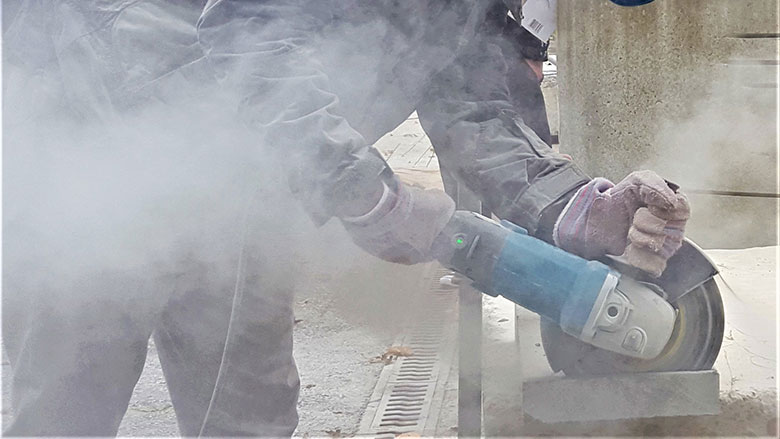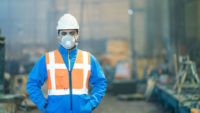Construction work produces harmful dust, fumes, and sprays that are harmful to workers' health. Two types of respiratory devices used on jobsites are air-purifying or atmosphere-supplying respirators. Determine what assigned protection factor is needed to protect your workers.
Jobsite respiratory exposures include:
- Concrete dust from cutting or mixing concrete-based materials,
- Hexavalent chromium fumes from welding on stainless steel,
- Lead particulates from grinding on lead-based paint, and
- Toxic air contaminants from sanding and spraying operations.
The construction industry uses OSHA's general industry Respiratory Protection Standard — §1910.134 — to protect workers. Most respiratory devices require the user to be medically cleared by a healthcare professional. Medical evaluations don't need to be repeated unless a worker has difficulty breathing or exhibits other signs indicating a need for re-evaluation. There are some exceptions to this medical requirement, like when workers voluntarily use a filtering facepiece—such as an N95.
Evaluate respiratory hazards
At §1910.134(d)(1)(iii), OSHA's Respiratory Protection Standard requires the employer to: "identify and evaluate the respiratory hazard(s) in the workplace; this evaluation shall include a reasonable estimate of employee exposures to respiratory hazard(s) and an identification of the contaminant's chemical state and physical form. Where the employer cannot identify or reasonably estimate the employee exposure, the employer shall consider the atmosphere to be immediately dangerous to life or health (IDLH)."
Consider the atmosphere to be IDLH, unless, under worst-case assumptions, exposures would not be IDLH. For example, some information may be available on air concentrations, but not enough data to reasonably estimate the actual employee exposures. However, by making reasonable assumptions about the maximum concentrations that could exist, the employer may be able to show that IDLH conditions would not occur. In other situations, it may not be feasible to identify all of the air contaminants. Still, through information on the process, you may be able to determine that IDLH conditions could not occur. This becomes more important when it comes to selecting the proper respirator.
As OSHA notes in its compliance directive, CPL 2-0.120 — Inspection Procedures for the Respiratory Protection Standard: "Although the most reliable and accurate method to determine exposure is to conduct personal air monitoring, it is not explicitly required by the respirator standard." Instead, other means can be used to estimate workplace exposures, such as the:
Use of objective data obtained from industry studies, trade associations, or from tests conducted by chemical manufacturers which demonstrate that air contaminants cannot be released in the workplace in airborne concentrations that are IDLH. The employer must document the use of objective data as part of their written program.
Application of mathematical approaches using data on the physical and chemical properties of air contaminants, combined with information on room dimensions, air exchange rates, contaminant release rates, and other pertinent data including exposure patterns and work practices.
The standard does not require that the person making the estimate have a particular credential. Persons trained and experienced in evaluating respiratory hazards posed by workplace atmospheres are the most competent to evaluate exposure levels.
Even though you can generally use estimates, keep in mind that OSHA's comprehensive substance-specific health standards (i.e., hexavalent chromium, lead, formaldehyde, methylene chloride, etc.) do have employee exposure monitoring requirements that you must follow if you use these substances.
Selecting a respirator
Selecting the right respirator is essential. In making the selection, several factors must be considered:
- Chemical identity and physical nature of the contaminants.
- Toxicity of the contaminants.
- Your exposure level — the concentration of the contaminants in the air, and the amount of time you will be exposed.
- Amount of oxygen present.
- The respirator's assigned protection factor and the maximum use concentration for
the application.
There are two basic types of respirators:
- Atmosphere-supplying, and
- Air purifying.
Atmosphere-supplying respirators provide clean breathing air from a source that is separate from the contaminated area. They should be used when:
- There is not enough oxygen in the area,
- Contaminant concentrations are unknown, or
- Contaminant concentrations are Immediately Dangerous to Life or Health (IDLH).
Air-purifying respirators pass contaminated air through filters, cartridges, or canisters to clean the air as it is breathed. These only protect against certain contaminants and should not be used in an oxygen-deficient or IDLH situation.
Using your respirator and staying healthy
Fit testing is required for any respirator with a tight-fitting facepiece (even those used in a
positive-pressure mode). The test must be conducted before initial use and at least annually. The type of fit test depends on the type of respirator and the types of contaminants that you are exposed to. A seal check must be done each time that a tight-fitting facepiece is put on. It is a quick way to test that the facepiece is adjusted properly.
Use the respirator as it was designed to be used. Follow the operating instructions from the manufacturer or your employer. Leave the area if you can smell or taste the contaminant; if you need to change cartridges, filters, canisters, or cylinders; if you need to wash your face or the facepiece; or if you have any problems with the respirator.
When someone is wearing a respirator in an IDLH atmosphere, at least one person who is ready to provide rescue must remain outside and monitor the person in the IDLH area. (For firefighting, at least two employees must go into the IDLH area, and at least two people must remain outside.) Some people may be trained to respond to emergencies such as confined space rescue, hazardous spill response, or interior structural firefighting. If you are not trained and authorized to perform these duties, follow your company's evacuation procedures in case of an emergency.
Follow these basic maintenance tips to ensure respiratory devices are clean and sanitary.
- If you are issued your own respirator, clean and disinfect it as often as necessary to keep it in a sanitary condition.
- If a respirator is shared, it must be cleaned before being worn by different people.
- Respirators used for emergencies must be cleaned after each use.
- Respirators used for fit testing and training must be cleaned after each use.
- Inspect your respirator each time that you wear it, and when you clean it. If it is damaged, have it repaired before it is used again.
- Store the respirator where it will stay clean and will not be damaged.
Remember, using a respirator puts additional stress on your body. Your health must be evaluated by a physician or health care professional before you can wear a respirator. Follow any recommendations from the evaluation. Report any signs or symptoms that may influence your ability to use a respirator, including shortness of breath, dizziness, coughing, wheezing, chest pain, chest injuries, lung diseases, cardiovascular conditions, or heart conditions.



